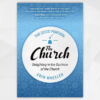4 Reasons to Preach through the Gospel of John
John has a singular purpose in writing his Gospel: he wants the reader to come to the conclusion that Jesus is in fact the Christ, the promised Messiah of the Scriptures, and that by coming to that conclusion, they will have life in his name (John 20:30–31). So in a very real sense, John’s Gospel is a long evangelistic tract. He lays out, with precision and intentionality, an argument to persuade whoever reads or hears his words.
So in line with his intent, here are four reasons why you should preach through the book of John.
1. To see the identity of Jesus.
John is interested in making sure people understand not just that Jesus is God, but that Jesus is the God of the Scriptures. From the very first chapter, John’s Gospel is drenched with Old Testament allusions and reference: there’s creation language; there are images and fulfillments of the sacrificial system and festivals; there’s Jesus asserting that he is one with I AM; there’s allusions to Ezekiel and Isaiah and Zechariah; there’s allusions to the Garden of Eden during the crucifixion and resurrection; and ultimately, there’s the claim that the entirety of the Old Testament Scriptures bear witness to Jesus.
I could go but, but John is trying to make it abundantly clear throughout his Gospel that this Jesus is the promised one of Israel. He is the King who will wear a crown and bring with him a new kingdom. He is the Prophet who will bring the very words of God to his people. And he is the Priest who will not just bring the lamb as a sacrifice, but who will then become the Lamb of the sacrifice.
2. To see the power of Jesus.
John’s Gospel gives us clarity regarding Jesus’ identity, and it also makes us witnesses to his power. John chooses which signs to write about on purpose. So while preaching through this book, you must wrestle with these questions: “Why did John choose this one? What’s he trying to show us about Jesus here?”
Jesus’ signs display his power, and they culminate in the resurrection of Lazarus. Whether it be in his sovereign power over creation (6:16–21) or his creative power from nothing (6:1–15) or his restorative power in healing (4:50, 5:8–9, 9:7, 11:43–44), John paints a powerful picture of Jesus. Miracle after miracle, he stands against our greatest enemies and speaks a word or thinks a thought and, immediately, the will of the Son must be obeyed. When we rightly teach Jesus’ power over sin and its consequences combined with his care for his sheep, we lead our people toward a peace that nothing in this world can take away (John 16:33).
3. To see the mission of Jesus.
John’s Gospel also focuses on the clarity and simplicity of Jesus’ mission. Jesus was sent by God to accomplish his Father’s will; he was sent so that people would believe in him, and so that Jesus might lose none of them (6:29, 39). Jesus was sent by the Father into a foreign land to bring with him the message of salvation for those who will believe. In a very real sense, Jesus is the first Christian missionary, and his purpose of coming to earth was to live as “the sent one” of God. This language of being sent saturates much of John’s Gospel and reveals to us how Jesus viewed his life and ministry.
It’s important for churches to understand how Jesus viewed his life. It wasn’t primarily theological or anthropological, although it certainly wasn’t less than that. Instead, Jesus came to accomplish a mission (his substitutionary sacrifice, his victorious resurrection) and to tell people about that now-accomplished mission; he came to save, and he came to evangelize.
4. To see the mission of Jesus’ disciples.
Simply put, Jesus’ understanding of his mission shapes the mission of his disciples. Jesus looks into their eyes after the resurrection and tells them, “As the Father has sent me, even so I am sending you” (20:21).
So the missional and evangelistic shape of Jesus’ ministry constrains his disciples and his church. There’s a lot of confusion out there about what a church should be doing and what its mission is. But Jesus lays it out clearly: we are sent just as he was, to spread his gospel so that people might believe in Jesus and that by believing in him they will find life in his name.
While preaching through this book, I loved to see how simple evangelism is. The evangelistic call of the earliest followers of Jesus was simply “come and see” (1:46, 4:29). People encountered Jesus and then went to bring others to his feet. The woman at the well wasn’t a trained theologian or missiology expert. She simply met Jesus and then wanted others to do the same.
As Christians, there’s a remarkable simplicity to our mission. To be a Christian is to be sent by Jesus. We encounter him, and then we go bring others to do the same, praying that people will believe in him and find joy to the fullest (15:11).
When we finished our series through John, one man from our church came up to me and said, “Caleb, I’ve grown up in church but I felt like I just met Jesus again for the first time.” John’s Gospel has a unique way of introducing or re-introducing us to Jesus. The book is hyper-focused on his person and work, and so we get intimate looks into his life that the other Gospels don’t provide (for example, the Upper Room Discourse and the High Priestly Prayer). John, “the one whom Jesus loved” (20:2), offers to us unique glimpses into the life of the Savior who has loved us.
The purpose of this book is for people to meet Jesus so that they will believe he is who he says he is, and finally find life, joy, and peace. Brothers, preach through this Gospel and bring your people to the feet of the Messiah to understand his identity, his power, his mission, and their own mission.
COMMENTARY LIST
D.A. Carson – The Gospel According to John (PNTC) – In regards to academic rigor and pastoral application, it just doesn’t get better than Carson. He deals with the complexities of the texts while always bringing it to bear to the life of the congregation. If you could only buy one commentary on John, it should be this one.
Andreas Kostenberger – John (Baker) – Kostenberger is similar to Carson in regards to scholarship and pastoral application. This commentary paints with a bit of a broader brush than Carson, which in many respects I found to be helpful.
Edward Klink – John (Zondervan) – This was the commentary that surprised me the most, but in a great way. I found it often to be textually insightfully and engaging. He includes an application section at the end of every section which was usually very helpful. There were times I felt he relied too much on the cultural context to shape his interpretation of the text (particularly in regards to rules of discourse and the stories of Nicodemus and the woman at the well).
J.C. Ryle – Expository Thoughts on the Gospel of John – I’ll put all of my cards on the table: Ryle is one of my favorite authors, period. And this commentary was no different. This work is a little light from an academic sense because it was originally written to be read by fathers during family devotion. But many of Ryle’s insights will not only be helpful for your sermons; this commentary will be helpful for your own soul.
R. Kent Hughes – John (Preaching the Word) – This homiletical commentary was outstanding. While this is not a good resource to begin your study with since it is his sermons transposed into a commentary and could thus shape your sermon more than you realize if approached early on, it is very beneficial towards the end of the week by providing some ways to view the text and apply it that you may have glossed over on your own.








